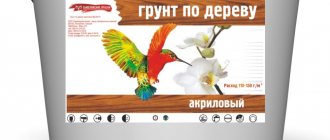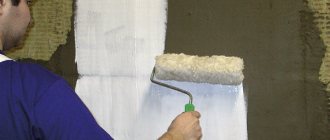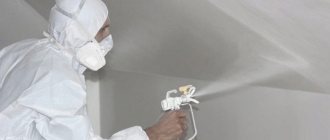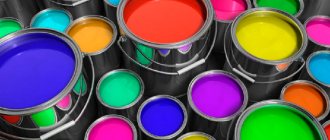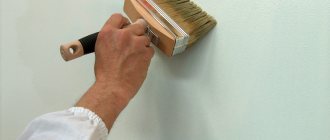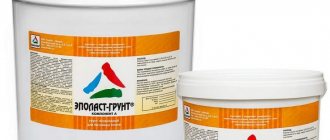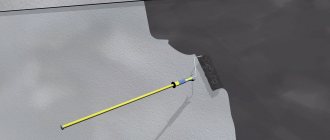Savig
8439 0 6
Savig December 5, 2016Specialization: master of interior finishing works. I am well versed in power tools for repair and construction. Formerly a teacher at a radio engineering college.
Photo of a canister with latex primer
A deep penetration latex primer will ideally prepare the walls, ceiling and floor of your apartment or country house for subsequent finishing work. It is easy to use and incredibly effective, its importance is difficult to overestimate. But you can underestimate, which is what many novice masters do from time to time. In this article I will try to dissuade you from such a rash step.
Purpose and application
Latex primer is used for treating exterior and interior spaces. Can be used for wood processing. The mixture works well on old, christened and untreated wood.
When treating a concrete surface, it is best to lay a layer of primer on top of the recently hardened mixture. The solution acts on concrete in such a way that it penetrates the pores and prevents crumbling. The latex solution acts similarly when applied to plaster.
Important! Latex primer is an integral part when processing metal surfaces. This mixture will prevent rust from occurring.
Features of choice
Before you begin finishing work, you need to figure out how to choose a primer in order to achieve the highest quality results. The need to choose a specific variety depends, first of all, on the type of surface being treated. In addition, the purpose of the room is important, since some of them have high humidity and other characteristics.
Before choosing a primer, you need to study its types as accurately as possible and select the option that will be most optimal depending on its properties.
Very often, people who have started a renovation are faced with the question: which primer to choose - acrylic or latex. It should be noted that both latex and acrylic have almost the same properties and can significantly reduce paint consumption. Here you need to pay attention to the type of surface being treated. The acrylic mixture is great for treating concrete or wood, but latex is an ideal choice for plaster or brick substrates.
Composition and technical characteristics
The latex-based primer contains the following components:
- drying accelerators;
- styrene acrylic latex;
- pigments;
- defoaming agents;
- oils;
- preservatives;
- antiseptic.
The list of composition can be expanded depending on the production technology of a particular product.
Water is used as a diluent for all formulations. There are primers that do not require thinning. The proportions for dilution are used individually by each manufacturer. The situation is similar with other characteristics and application features: drying time, density, application temperature, shelf life, suitable material.
Consumption per 1 m2
Consumption per square meter depends only on the composition used. To calculate the approximate amount of the required substance, special calculators are used. But they do not give an exact number, since the calculation is strictly approximate. It is not the specific characteristics of the material being processed that greatly influence the amount of solution required. Most types of latex mortar have a consumption of about 80-120g/m2.
Application in repair
The scope of application of latex primers is quite extensive and they can be used for working with indoor surfaces, carrying out facade and street repair and finishing work.
Latex-based primers can be used to treat untreated and painted wooden surfaces; they can also be used with old wood that has been exposed to open conditions for a significant period of time.
Latex primer mixtures can be used on wood bases, but if you have to work with an untreated wood base that releases resinous substances, it is better to choose an alkyd solution for priming.
We use latex primer for the preliminary preparation of cement, concrete and plastered surfaces. The solution will penetrate into the pores of the base as deeply as possible and qualitatively strengthen it from the inside, thereby preventing the unwanted process of shedding. Since the material dries quickly, it is ideal for use where “fresh” surfaces need to be quickly prepared for painting or cladding.
Latex-based solutions are also suitable for working with metal surfaces: the use of primer will help protect the base from corrosion processes and rust.
Since latex primers are universal, they are suitable for treating all types of premises. This quality of primer mixtures helps to save not only on the consumption of finishing materials, but also on the purchase of the composition itself: there is no need to purchase a separate solution for each surface.
Tips and recommendations for use
Regardless of whether the composition needs to be diluted or not, the mixture must be stirred. This will allow the particles settled below to be evenly distributed in the composition.
The operation of the latex primer is simple. To do this, you must act according to the compiled algorithm:
- Prepare the surface for applying the mixture. To do this, all stains on the base, rust, fungus and other contaminants are removed. Afterwards, cracks, cracks and unevenness are sealed using putty.
- Dilute the soil in accordance with the ratio indicated on the package (each manufacturer makes its own composition, so the proportions may differ).
- Treat the surface with a primer using a roller, brush or spray. During this procedure, the temperature during application must exceed 10 degrees Celsius, and the air humidity must be more than 75%. Such parameters are necessary for high-quality and rapid hardening of the mixture.
- Wash the instruments from the composition.
Important! Paint or glue can be applied to the prepared surface only after the mixture has dried, as evidenced by the formation of a polymer film. If you start the painting or pasting procedure earlier, the quality of the work will be at a low level.
The primer technology itself consists of three stages:
- The primer mixture is poured into a tray or other small container.
- Hard-to-reach places are treated with a brush. Window slopes and doorways are processed especially carefully.
- The remaining surfaces are processed using a roller. After each dipping of the roller, it must be squeezed out of excess mixture.
To achieve a strong layer of primer, the procedure must be carried out twice. In this case, the surface will be maximally saturated with the composition. The wall must be allowed to dry between coats.
Universal latex-based primers
These materials are used to strengthen surfaces.
They treat bases from:
- concrete;
- plasters;
- bricks;
- Chipboard.
The specially selected composition of the material makes it possible for the surface to:
- significantly increase its strength parameters;
- increase reliability to various influences;
- improve adhesion with the topcoat.
Colorless universal primer
Advantages of the material
Typically, each substrate has its own primer, which is designed specifically for it. For example, when processing loose surfaces, a deep-penetrating composition has proven itself well, and for metal, an anti-corrosion composition.
If you find it difficult to choose a product, opt for a universal primer, the price of which is consistent with its characteristics.
This composition can be used to treat surfaces made of:
- concrete;
- bricks;
- cardboard;
- plasters;
- drywall;
- aerated concrete.
The composition is often used for tongue-and-groove slabs, gypsum and cement-sand screeds and cinder blocks. For indoor use only.
Among the advantages can be noted:
- environmentally friendly, as it is made on the basis of acrylate. Does not emit harmful substances during operation;
- increasing the strengthening characteristics of the surface;
- reducing the absorbent parameters of the base, which is especially important for loose and weak surfaces that can absorb a lot of paint and varnish;
- quick drying, approximately 2 hours;
- resistance to chemical-based solvents used for cleaning;
- increased adhesion;
- good hydrophobicity;
- antibacterial properties, so the treated surface is not afraid of mold, mildew and other putrefactive microorganisms.
Latex primer “Snezhka” for interior work
Tip: universal anti-fungal latex primer can be used in damp areas.
Applying latex primer
- Prepare the base. Make sure that there are no grease or oil stains, grease, dirt, rust or wax left on it, i.e. anything that could become an obstacle to normal surface treatment.
- Be sure to repair cracks and weak areas with your own hands. Wait until they dry.
Tip: It is advisable to check the substrate for the amount of moisture it contains using an electronic or carbide moisture meter. For gypsum surfaces the figure should be 0.6%, for cement-sand and concrete surfaces - 4%.
- Cover the floor and furniture with plastic sheeting. Check the room temperature, it should be at least +10 °C, the humidity setting should be 75%.
- Prepare the solution; the instructions on the package will tell you how to do it correctly.
Applying primer to the wall with a roller
- Apply the mixture with a brush, brush or special roller. Consumption for a normal surface will be approximately 7 square meters. meters per liter, for absorbent - 11 sq. m. The mixture should be applied evenly over the entire base.
Tip: to make the solution truly penetrating, apply a second layer after the first layer has dried.
- Finishing work can begin only after the soil has completely dried.
Professional recommendations
- Try to apply primer only to dry surfaces.
- Monitor humidity and temperature readings.
- Carry out work wearing protective gloves and clothing. If the composition gets on the skin, it should be washed off immediately with water.
Penetrating latex primer
- Upon completion of work, tools should be immediately washed with water.
- Store the mixture in a dark place, make sure that children do not have access to it.
Advantages and disadvantages
Advantages of latex-based primer:
- safe for people and animals, there are no harmful emissions that are characteristic of other types of primer;
- dries quickly;
- low cost of the mixture;
- the treated surface becomes resistant to moisture;
- prevents the occurrence of rot and mold;
- increasing the adhesion of the material to the paint;
- resistance to low temperatures.
This primer can even be applied to old paint or a surface that has not been prepared. And thanks to the wide selection, the buyer will be able to choose the color scheme that he requires.
Disadvantages of latex-based primers:
- high consumption of concentrated substance;
- does not have full characteristics for individual types of coating, since the composition is developed for all types of materials at once;
- the solution must be prepared in strict accordance with the proportions.
Often, latex primer is used as a coating preparation for parquet varnish, enamels, oil paints, plaster and marble chips.
Benefits of priming
It is imperative to prime the surface before performing finishing operations so that the repair can please the owner’s eye for a long time. We list the main advantages of using a primer:
- Strengthening adhesive properties. After applying the primer, microparticles of the paint and varnish material adhere to the surface, which ensures adhesion. It doesn’t matter what the surface is (brick, concrete, wood, painted or plastered) - the functions of the primer apply to all types of base.
- Reduced consumption of finishing material. When painting or puttying walls, sometimes a lot of material is wasted, even though the consumption per 1 m2 is indicated as one, but in reality much more is applied to the surface. This happens because the surface is porous and the pores absorb paint or putty. When using a primer, the surface is saturated and its pores are filled; accordingly, the consumption of material for subsequent finishing is significantly reduced and corresponds to the consumption specified by the manufacturer.
- Surface strengthening. Without intermediate priming, after applying paint or putty, microcracks appear on the walls, and they cannot be eliminated by any means. After applying the primer, all existing defects on the surface are saturated, and the base becomes durable and suitable for further finishing operations.
- Creation of a waterproofing layer. Small watery drops may appear on untreated surfaces, but the primer provides protection from high humidity, which prevents the formation of mold and mildew.
- Help in painting over dark tones. After painting the concrete surface, it is noted that the gray color still appears. By adding white pigments to the primer, the treated base becomes lighter, and the applied paint better covers dark spots.
Types and properties of latex primer
There are latex primers that are ready to use immediately and those that need to be prepared before work. Therefore, before starting priming, you must carefully read the instructions included with the product.
Latex primers differ from each other in several ways:
- surface for application;
- hardening time;
- density.
Depending on its purpose, the latex mixture is suitable for processing:
- aluminum;
- concrete;
- drywall;
- wood;
- bricks;
- plastered and putty surfaces.
The latex primer shows excellent results on porous surfaces such as drywall or concrete, due to its deep penetration property. The solution works similarly with a wooden base. All pores in loose and uneven surfaces will be protected by the penetrating compound.
Acrylic and latex primer - what is the difference?
Many people wonder which primer is better - latex or acrylic? It would seem that both materials are intended for preparatory work when processing bases. But you can decide which one to choose only by studying the manufacturer’s instructions.
When choosing, you should take into account that the difference between these two materials is that acrylic will not protect against corrosion, while latex will provide this protection. In addition, the latter can still be used in damp areas. The materials also differ in composition.
Advice! If you have any doubts when choosing, it is recommended to contact a sales consultant and find out exactly how one and another product differs.
Advantages of a universal latex primer
Latex primer was originally created so that it could be used on almost any combination of surface and applied material. The main distinguishing feature of the mixture is the depth of penetration, which ranges from 5 to 10 centimeters.
A latex-based product will only emit water vapor when applied to the surface. Unlike alternative options, which can release harmful and toxic substances in small quantities, latex primer is completely free of this disadvantage. It is safe for children, adults and animals, therefore it is used in residential areas.
The composition completely ignores the effects of moisture. This property allows it to be used in rooms with high humidity, such as a bathroom or kitchen. To this property is added resistance to low temperatures. Taken together, these parameters make it possible to use latex mortar when finishing facades.
Fungus will not be able to form on the treated surface due to clogging of all holes. The latex-based composition is “liquid rubber”, which fills all the pores on the surface.
Fast-acting formulations will create a film in half an hour. Thanks to this, interruptions during construction will be minimal.
Types of primers
The manufacturer today offers a variety of building materials, but in order to determine what exactly is needed for finishing work, it is important to know the main types of primers, their characteristics and properties, as well as what they are intended for.
Acrylic or water-based
This primer is intended for treating any surface (wood, plaster, plaster, brick or concrete). However, it is not suitable for metal, since rust begins to appear after coating. The name “water-based acrylic primer” speaks for itself; this means that the composition can be diluted with water. The material dries quickly - within 4 hours. No toxic substances are released. Used in residential areas.
Primers of this group are available for both superficial and deep penetration.
Latex
Used for priming brick, concrete, plastered walls or particle board bases. The composition is specialized, promoting:
- ensuring the strength of the coating;
- increasing resistance to external negative factors;
- improving surface adhesion to finishing.
Latex primer for indoor work is suitable for porous surfaces, it is ideally absorbed, which allows further finishing operations to be carried out with minimal consumption of material. The composition helps to level the joints of plasterboard sheets and plaster.
Latex-based facade primer is applied before painting facades with latex paints. Forms a thin and durable film that is resistant to bubble formation. Can be used on previously painted substrates.
Alkyd
Used for priming wooden surfaces before painting, ensuring adhesion (cohesion) of the applied paint and varnish material and the base. The service life of wooden structures increases. This soil dries completely after 16 hours.
This type of primer is also good for metal processing and may have anti-corrosion properties, but the composition is not suitable for mineral substrates.
Other types of soil
| Soil types | Functional purpose | For what surfaces are they used? |
| Polyurethane foam and epoxy | The principle of their operation is similar to coating with paints and varnishes, i.e. Such primers are similar to paints that have been thinned with solvents. Most often, concrete bases are treated with such compounds to prepare the surface for coating with special enamels. | Concrete floors, cement screed |
| Shellac | They are used to treat areas from knots or other defects in wood. Can be used by mixing with stain. | Wooden base |
| Polystyrene | They provide strength to the base, but are highly toxic materials, so they are not recommended for use for interior finishing work. | Wood and plaster |
On the video: types of primers and their characteristics.
Review of popular manufacturers
The building materials market is filled with various latex primer offers. The most popular products are:
- "Text Pro Moisture Protection" from domestic. Designed for processing concrete, plasterboard and plastered surfaces. Density is 1000 g/l. Used for interior work.
- "Optium" from domestic. The composition has a density index from 1000 to 1100 g/l. Before application it is diluted with water. The dry residue is 5%. Used for interior work. Under suitable conditions, it hardens in 40 minutes.
- Domestic latex primer. Suitable for concrete, tiles, wallpaper and paint. The curing period is 60 minutes.
- "Seal Grip" from domestic. Suitable for processing concrete, plasterboard, glass, plastic, wood, aluminum, plastered and galvanized surfaces. The amount of dry residue is 2%. Used for interior work. Under comfortable conditions, it hardens in 60 minutes.
- "Sniezka" from the Polish manufacturer of the same name. Designed for processing concrete, metal and wood. Diluted with water. In the dry residue the amount of substance is 5%. Used for interior work. The composition will take 2 hours to dry.
Latex primer allows you to create high adhesion to almost any surface and finishing material. This is one of the best ways to prepare the surface for further work, because the composition penetrates into all cracks, filling them. The mixture will protect the wall from moisture, the consequences of its exposure and other environmental factors.
Why latex
Most often you can find two large groups of priming solutions:
- solvents in their composition ;
Example of an alkyd primer
- Latex, created on a water basis .
Deep penetration latex primer in a bucket
The second group has a number of advantages that personally tip my hand in favor of their use, at least in everyday life.
Advantages
Before moving directly to the description of the advantages of the substance in question, I want to explain what the difference is between latex and acrylic primers. If you don’t go into chemical formulas, then nothing : the presence of latex or acrylic in the soil gives it absolutely identical properties. Keep this in mind when shopping to avoid confusion.
And now, in fact, the advantages themselves:
- Complete safety during use and after hardening . All that acrylic or latex primer is capable of releasing into the air is only water vapor, which cannot harm children, allergy sufferers, or pets;
Even ceilings in a child’s room can be treated with a latex-based primer without fear for the child’s health.
- Significant increase in resistance to dampness . “Liquid rubber,” as I noted above, qualitatively clogs the pores of the material being processed, eliminating the possibility of the formation and spread of fungal spores in its structure;
Latex antiseptic and hydrophobizing primers do an excellent job of protecting against excessive humidity
- High hardening speed . Most compositions form a durable polymer film within two hours after applying them to the surface to be treated. This allows repairs to be carried out without significant interruptions;
- Relatively low price . Refusal to use expensive solvents also benefited the final cost of the product. Water is much cheaper.
Regarding the last point, I don’t want to be unfounded here and will give specific examples of latex primers that can be found today at specialized points of sale:
Offers from manufacturers
- "Tex Pro Moisture Protection":
| Parameter | Description |
| Firm- | |
| Country of manufacture | Russia |
| Surface to be processed |
|
| Density indicator | 1000 g/l |
| Container weight | 9000 g |
| Binder | Latex |
| Application tools |
|
| Type of work | Domestic |
| Price | 2136 rubles |
Latex-based primer “Tex Profi Moisture Protection”
- "Optimum":
| Parameter | Description |
| Firm- | |
| Country of manufacture | Russia |
| Diluent | Water |
| Density indicator | 1000-1100 g/l |
| Container weight | 10000 g |
| The amount of dry residue | 5% |
| Binder | Latex |
| Application tools |
|
| Type of work | Domestic |
| Curing period | 40 minutes |
| Approximate consumption | 1 kg per 5-14 m2 |
| Price | 540 rubles |
Sample of penetrating latex primer “Optimum”
- "Prospectors":
| Parameter | Description |
| Country of manufacture | Russia |
| Diluent | Water |
| Container weight | 5000 g |
| Binder | Latex |
| Application tools |
|
| Type of work | Domestic |
| Curing period | 60 minutes |
| Approximate consumption | 100-200 ml per 1 m2 |
| Price | 215 rubles |
Sample of latex primer “Prospectors”
- Seal Grip:
| Parameter | Description |
| Firm- | |
| Country of manufacture | Russia |
| Surface to be processed |
|
| Diluent | Water |
| Alkaline resistance | 13 ph |
| The amount of dry residue | 2% |
| Binder | Latex |
| Application tools |
|
| Type of work | Domestic |
| Curing period | 60 minutes |
| Approximate consumption | 3.8 l per 37-46 m2 |
| Volume | 3.8 l |
| Price | 1900 rubles |
Sample of “Seal Grip” latex primer
- "Sniezka":
| Parameter | Description |
| Firm- | |
| Country of manufacture | Poland |
| Surface to be processed |
|
| Diluent | Water |
| Density indicator | 1.6 g/cm3 |
| Container weight | 3000 g |
| The amount of dry residue | 5% |
| Binder | Latex |
| Application tools |
|
| Type of work | Domestic |
| Curing period | 120 minutes |
| Price | 168 rubles |
Sample of latex primer “Sniezka”
Preparing the base
Before applying a latex-based primer, the surface of the base must be prepared. Required tools:
- Wide brush.
- Thread or fur roller.
- Special trough for soil.
- Rag.
To prepare the base, it is necessary to remove all dust, mold, grease stains, and construction dirt. If necessary, the surface of the base is treated with a special antiseptic. After the preparation procedure, the wall should dry well. If cracks are noticed on the wall, they are first opened and then sealed with special mixtures or plaster.
Application of primer
If the room is furnished, then all items should be covered with plastic wrap, also protecting all other surfaces, such as floors, because primer stains are quite difficult to remove. It is also important to protect your eyes, head and skin when working with building materials. Glasses, a hat and thick work clothes are quite suitable for this.
Important! Work must be carried out at an ambient temperature of at least +10 ° C and at an air humidity of no more than 75-80%.
The solution is poured into a tray, after which the required areas are treated with a roller. You can also use a brush to prime hard-to-reach areas. Experts recommend applying primer to the base in two layers, so that the surface is completely saturated with the primer mixture. Each subsequent layer of emulsion is applied after the previous layer has dried. If the mortar comes into contact with your skin or eyes, rinse them immediately with clean tap water.
Application of primer mixtures
Following the technology of finishing work associated with the need to prime surfaces, before applying paint you need to:
- be sure to prepare the surface by cleaning it from old paint, traces of dirt, dust, and various stains;
- level and repair damaged areas if the surface is covered with cracks, dents and other types of defects;
- Allow the base to dry after preparatory work.
During surface preparation, a metal scraper and sandpaper can be used to remove flaking and loose old paint. Stains can be removed by washing the contaminated areas with water and detergent. Oily, greasy stains are treated using white spirit and other solvents.
When cleaning surfaces, it is worth changing rags more often.
Primer mixtures are sold ready to use. In cases where the solution needs to be prepared in any way before use, proceed according to the instructions included with the product.
In any case, the primer mixture should be thoroughly mixed before use. This is done so that the particles that settle to the bottom are evenly distributed inside the composition.
Primer mixtures are applied to the surface depending on its area using a roller or spray gun or airbrush. Which primer is better, acrylic or latex? So that the composition can be sprayed with a spray gun, it is diluted to the required thickness.
To increase the quality of the film formed when the soil dries, it is applied in two or even three layers. The consumption of deep penetration primer mixture depends on the porosity and area of the surface being treated, and the number of layers of soil.
Each new layer of primer is applied only after the previous one has completely dried.
Primer TIKKURILA
This type of priming solution is characterized by excellent adhesion to clean and previously painted surfaces with paints and acrylics. Matte acrylic-latex primer is used for treating concrete, cardboard, plastered, putty, brick surfaces, as well as wood chip and wood fiber boards.
A universal type of acrylate-based primer contains additives that protect the paintwork from mold.
What primer should I use?
When choosing a primer, it is important to consider:
- Type of base.
- Type of finishing material.
To achieve a high-quality result, you need to select a primer that will most effectively connect the base with the cladding or act as the necessary intermediate layer.
When deciding which primer to use, take into account the conditions of finishing work and operation. Of great importance are: temperature conditions, humidity levels, ventilation or airing efficiency, and the presence of contact with water.
Main types of primers
From a functionality point of view, the following types of primer materials are distinguished:
- universal;
- adhesive;
- deep penetration;
- water-repellent;
- antiseptic;
- anti-corrosion.
Which primer is better depends in each case on what tasks it should solve.
Universal
In most cases, when special protection and maximum surface strengthening are not required, a universal primer is a reasonable solution. It has a balanced composition, is relatively inexpensive and, at the same time, copes well with basic tasks. This primer binds dust and contaminants on the surface, provides the necessary adhesion, and reduces the consumption of facing material.
Adhesive
It is often necessary to finish smooth, poorly absorbent or non-absorbent, very dense substrates. To create an “adhesion bridge,” a special adhesive primer is used. Its main function is to adhere the base to the finishing material.
One of the most prominent representatives of adhesive soils is concrete contact. It is indispensable when you need to finish a poorly absorbent surface - for example, when plastering a wall with old paint or tiles. The material contains adhesives and quartz sand, which improves adhesion.
Deep penetration
If the base is too weak, loose and has increased absorbency, a deep penetration primer is used before cladding. It creates a fairly deep layer at the top of the building material - concrete, brick, plaster, plaster or drywall. This strengthens the weak porous base. At the same time, a reliable film is formed on the surface, preventing the absorption of paint or glue. It also limits the access of moisture.
Water repellent
If the cladding is used in conditions of high humidity or exposure to water, the water-repellent properties of the soil come to the fore. It is necessary to ensure reliable protection of the building material from premature destruction under the influence of steam and moisture. For this purpose, a special water-repellent impregnation is used. It simultaneously performs the functions of a primer and insulation - it ensures adhesion, preventing water from penetrating into the material.
Antiseptic
When treating surfaces in a room exposed to humidity and without effective ventilation, it is recommended to use antiseptic primers. They have the properties of universal primers, but additionally contain antimicrobial additives. This prevents the development of microorganisms and fungi, which progress especially actively in a humid and warm environment.
If you have to prime the walls in the bathroom or on the loggia, there can be no doubt about which primer is better - of course, antiseptic.
Anti-corrosion
Special anti-corrosion primers contain substances that prevent premature destruction of building materials under the influence of moisture and water. There are anti-corrosion primers for metal (against rust), for wood (against rot), for concrete and reinforced concrete.
Selecting a primer based on base material
If the question arises about how to choose a primer for walls, you can focus on the base material. The primer composition must correspond to it - namely, it must best adhere to the building material, and, if necessary, strengthen and protect it.
Certain soils are suitable for each type of building foundation:
- Acrylic
- for concrete, brick, plaster, drywall, wood. As you can see, materials based on acrylic polymer are quite versatile in use. They connect equally well to the main types of bases (except metal), are effective and affordable. They are strengthening and penetrating. - Water-dispersed
- for all types of substrates, except metal. These are the same universal primers that are made in an aqueous solution. They are cheaper than acrylic and are considered more environmentally friendly, therefore they are preferable for interior work. Many water-dispersed compositions lose their properties at sub-zero temperatures. - Epoxy
- for concrete and metal. They are made on a resin basis and come in one- and two-component types. Epoxy primers can be used to treat concrete walls and floors. Zinc-rich compounds are suitable for painting metal structures. - Alkyd
- best suited for metal, but can be used for wood and plaster. These compounds are not able to penetrate deep inside and strengthen the base. They have a pungent odor and are not recommended for residential premises. - Shellac
- for wood. These soils strengthen the surface and isolate the massif from external influences. They preserve the beautiful natural grain of the wood and prevent it from being damaged by insects.
Acrylic primers have gained the most popularity today - as the best value for money. However, to solve specific problems it is better to use appropriate special solutions.
Selection by cladding material
For each primer product, the manufacturer must indicate what type of cladding it is suitable for. This information is usually printed directly on the front of the package.
It would seem that the question of how to choose a primer for wallpaper or plastering should disappear by itself. But not everything is so simple, because there are universal products that are suitable for plaster, wallpaper, and painting. Therefore, when choosing, you should carefully read the composition and clarify the properties of the primer material.
Which primer is best for plaster?
Before applying the plaster mixture to the surface of a wall or ceiling, the base must be primed - primarily to improve adhesion. Even a thin-layer coating has a significant mass, and in the absence of proper adhesion, under the influence of gravity, it can come off from the base.
Both universal and special adhesive primers can be used for plasters. Under normal conditions, a universal primer composition is also suitable for thin-layer plaster coating. However, professionals prefer more reliable solutions.
To guarantee a high-quality and durable finishing result, it is better to choose special primers. They come in water-dispersed and acrylic. Moreover, all primers for plastering work contain particles as a filler that promote improved adhesion to the material - concrete, brick, plasterboard, chipboard, etc.
Quartz sand and micromarble act as fillers that increase adhesion. Any other crumb of sufficiently strong and hard material that creates the necessary roughness can be used. Preference is given to mineral fillers.
For decorative plasters
When choosing a primer for decorative plasters, it is important to take into account not only the practical, but also the decorative properties of the material. The best primers prevent the base from showing through and have a white color ideal for tinting. No less important is such an indicator as coverage - uniformity of application.
From a practical point of view, a high-quality primer for decorative plaster is in no way inferior to its analogues: it provides excellent adhesion, reduces water absorption and reduces the consumption of the plaster mixture.
Primers for paint
When choosing a primer for painting, you should first of all proceed from the composition of the paint and varnish material with which the surface will be coated. To achieve maximum adhesion, you should use primer and paint of a homogeneous composition:
- An acrylic primer is best suited for acrylic-based water-dispersion paint.
- Under silicate paints, you can use a primer based on liquid glass (silicate).
- For silicone paints, a primer composition is intended with the addition of an appropriate silicone emulsion - silicone primer.
Special primers for painting not only provide improved adhesion, but also level the surface to be painted, facilitate painting work, and significantly reduce the consumption of expensive paint.
Primers that are homogeneous in composition can also be used to dilute paints.
Primer for wallpaper
There is no consensus among professionals which primer is best for walls under wallpaper. The choice of material is carried out in the same way as in the case of paints and plasters - based on the type of base and the type of finishing material (wallpaper). You should also consider the type of glue used.
If the walls to be pasted are old - with a weak, loose surface, prone to cracking - it is better to choose deep penetration compounds. They strengthen the base, preparing it for pasting. Often, a “face” primer is applied over the strengthening primer - for example, if you need to even out the color of the walls.
On smooth concrete and paint, adhesive primers are used to create roughness. It is recommended to use the same primers for heavy - embossed, non-woven - wallpaper.
When choosing which primer for wallpaper is better, the characteristics of the room are also taken into account. For the kitchen, it is advisable to buy soils with moisture and bioprotection.
Primers for indoor and outdoor use
All primers offered for sale are divided into 3 groups:
- For interior work.
- For external and internal works.
- Facade.
Soils intended for indoor use are not designed for sub-zero temperatures. They retain their best properties at a constant temperature close to room temperature. The advantage of such primers is environmental friendliness - complete safety for human health and the environment. Typically, such materials are made on a water basis, without the addition of chemical solvents. They are comfortable to use due to the absence of a strong odor.
The environmental friendliness of universal primers for exterior and interior work corresponds to those that are suitable only for indoor use. They can also be made on a water basis, but are necessarily enhanced with artificial additives that increase resistance to temperature changes, humidity and other external factors. The best compositions can withstand freezing down to -50°C.
Special façade primers are manufactured for outdoor use. They may have a pungent odor due to the use of solvent. Artificial additives increase resistance to environmental factors, including dirt, mildew and mold. Thus, the façade primer provides additional protection for the façade walls.
When choosing any primer - both internal and external use - you must carefully read the manufacturer's instructions. To guarantee a high-quality result, it is important to comply with the conditions under which priming work is allowed.
What else to consider when choosing a primer
To choose the best primer, you always compare factors such as price and quality. Quality is usually understood as the practicality of the material in terms of adhesion and protective properties, although there are other significant criteria. And the price is a relative value, depending not only on the volume of the product, but also on the consumption of the product, as well as on the characteristics of application.
Important soil selection criteria:
- Vapor permeability - primed walls can withstand moisture, but at the same time they must allow gases to pass through. This is especially important for normal air exchange between the street and the premises.
- Available application methods - primers can be applied by brush, roller, spray, spatula and other methods.
- Drying speed indirectly determines the cost of construction and finishing work, since it affects the total finishing time.
- Product consumption is the amount of product required to prime a certain area in one or two layers, taking into account the possibility of dilution with water.
